Federal Style
Federal style structures are understated inside and out. Frequently characterized by simple squares and rectangles, they are usually fewer than three floors. The front door is usually the most decorated or dramatic part of the exterior.
-

Rutledge College
South Carolina College was completely housed in Rutledge College the first four years. The central portion housed classrooms, laboratories, a library and the chapel, while wings on either side provided faculty and student housing.
-

DeSaussure College
Originally designed as a mirror of Rutledge College, DeSaussure included an academic center with dormitory wings. Archaeological research in the 1970s revealed the building’s foundation was first dug about 200 feet south of where it now stands.
-

South Caroliniana Library
The then-named South Carolina College Library was completed in 1840 and carries the distinction of being the nation’s first freestanding university or college library. Wings were added to both sides of the library in 1927.
Neoclassical
Neoclassical era designs include ancient Greek and Roman elements. Often having symmetrical floor plans, simplistic buildings are massive in scale and include elements such as vertical columns and classical exterior detailing such as entablature.
-
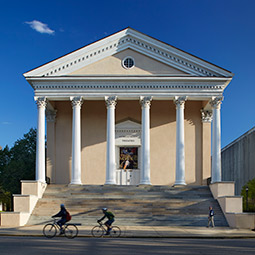
Longstreet Theatre
Longstreet Theatre, originally an auditorium and chapel, features a raised portico flanked by six Corinthian columns. Previously used as a Civil War military hospital and science facility, it was converted into gymnasium in 1893 with a rear annex added in 1939 for a swimming pool.
-

Barnwell
Completed in 1910, Barnwell was the second building constructed on Gibbes Green. Initially named LeConte, it was renamed in 1950s and, in 1970, experienced a devastating fire that allowed an additional floor to be added to the building’s shell.
-
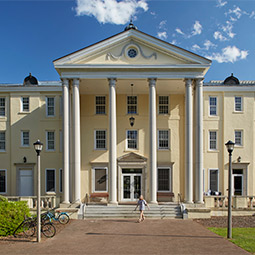
Sims
Sims arrived on campus in 1939 thanks to the Public Works Administration, a Depression-era New Deal program. It was the second women’s residence hall on campus. A 2013-14 renovation connected the three women’s quad residence halls and achieved LEED (Leadership in Energy and Environmental Design) Gold certification.
Midcentury Modern
This post World War II American architectural movement prioritized function over form. Hallmarks of midcentury buildings include a low footprint, minimalist style, open interiors, integration of materials such as glass, steel and concrete, and floor-to-ceiling windows.
-

Russell House
Originally planned in the classical style and in place of the dilapidated McCutchen House, the student union was built on Green Street’s Melton Field with a modern design and contemporary façade.
-

Sumwalt College
This 1955 structure was the first to veer from traditional campus architecture. The boxy, minimalist midcentury building, once home to the engineering college, is now used for research and other academic functions.
-

Thomas Cooper Library
The first iteration of Thomas Cooper Library was a small building to support McKissick, the main campus library. The Edward Durell Stone design underwent an expansive 1976 renovation to consolidate the university’s holdings, adding four underground levels and three above-ground floors.
Brutalist
Popular from the mid-1950s to the 1970s, these buildings lack ornamentation and emphasize building materials such as raw concrete. Soaring ceilings, massive walls and exposed concrete add to their block-like, hulking appearance.
-
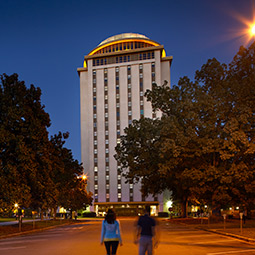
Capstone House
The 18-story Capstone House residence hall located on the east campus is topped by a revolving restaurant, driven by a platform and mechanism originally built for the 1964-65 New York World’s Fair. The residence hall and conference center was built in 1967.
-
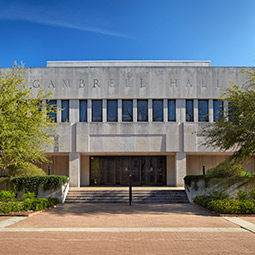
Gambrell Hall
The campus’ social science center, Gambrell Hall, is a substantial building completed in 1976. Using a new building approach — the “fast-track” method — the building was finished in just 26 months. The exterior is sheathed in Indiana limestone.
-
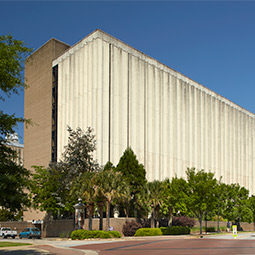
Coker Life Sciences Building
This seven-story Sumter Street facility, originally called the Biological Sciences Center, was built for research, instructional laboratories, classrooms and offices of the Department of Biological Sciences. An adjoining building was added to house the pharmacy college.
Contemporary
Advances in materials and construction have freed contemporary architecture from a single visual or interior style. Designs may incorporate curved lines, asymmetry, open spaces or abundant windows alongside modern utilitarian aspects such as technology and sustainability.
-
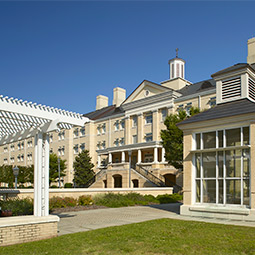
Green Quad
Formerly the West Quad, the Green Quad was the first LEED-certified building on campus, earning Silver designation in 2004. The quad blends traditional architectural detail and modern sustainability features.
-

Horizon Building
This five-story, scientific research facility, the first addition to the Innovista research district, houses primarily energy-related research teams. The labs are flexible and upfitted with movable furniture and equipment that respond rapidly to change.
-
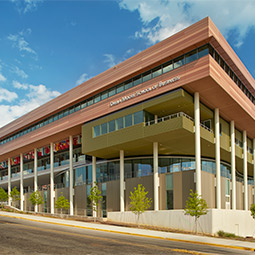
Moore School of Business
The Moore School, designed by Rafael Viñoly Architects, is first public building in South Carolina to earn LEED Platinum certification. Completed in 2014, the building maximizes site elevation changes with multiple-level entrances, dramatic views and collaboration spaces ranging from the interior courtyard to the rooftop terraces.
Featured photos by Rick Smoak Photography